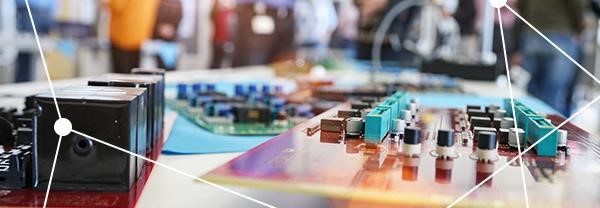complexity of sensorless FOC, especially for high-speed motors, is quite high. However, FOC brings benefits in terms of improvements in the efficiency and reduced torque ripple/vibration crucial for camera operation.
From toys to tools – Multicopters get serious

Initially regarded as toys, multicopters are now serious business. From simple surveying to future delivery solutions, entire businesses are emerging around the design, supply, and use of multicopters. With increased adoption comes increased regulation and the multicopter itself needs to be capable of being piloted in a safe and well-controlled manner.
While traditional aircraft designers devote a lot of effort to solving aerodynamic and mechanical challenges, the rapid development of MEMS-based microelectronics has focused multicopter design efforts on the electronics portion. Model based electronic control allows the reduction of aerodynamic instability, which leads to increased flight performance and maneuverability.
Multicopters brought new possibilities for unmanned aerial vehicles. Seen from a commercial perspective, the most prevalent civil application is the flying camera, which often includes follow me functionality and autonomous navigation.
As fast as the technology is growing, so is the surrounding legislation. Many countries – including the USA, Germany, and the UK – are drafting guidelines and rapidly developing legislation to limit where and how multicopters may be flown as well as defining unacceptable uses and licensing requirements for pilots – especially for anyone planning to use a multicopter to deliver a commercial service.
The legislation also, to an extent, drives the technology. It is not acceptable to have multicopters falling out of the sky or colliding with other objects – buildings, power cables or, worst of all, commercial flights. There are many important areas in multicopter technology but the advent of this legislation puts power management, motor control and vision, and sensing at the forefront of ensuring that multicopters are capable of safe, sustained, and controlled flight.
Rapid system solutions
Figure 1 illustrates the main electronic sub-systems for a professional multicopter. As the diagram shows, these devices are sophisticated systems in their own right. The major differentiator between toy drones and professional multicopters is the complexity of the control system. In hobbyist applications, to be able to fly and provide fun is enough. In professional applications, multicopters must provide a useful function on top of simply flying. Most often this is a vision system that requires video processing, gimbal control, and other functionality which is integrated into the control system.
One of the simplest, fastest, and lowest risk ways to implement a multicopter using the benefits of Field Oriented Control (FOC) is to begin building from the base of a good reference
system. One such comprehensive system is the Infineon multicopter demo board with XMC4500 flight controller and iMOTION™ motor controller, shown in Figure 2. The motor
control boards are plugged on the arms of the board and can be exchanged easily, thus a fast comparison of the performance of BLDC and FOC solutions is possible.
At the heart of the system is the flight controller, which is built around an Infineon XMC4500 ARM® Cortex™-M4 32-bit microcontroller. For easy starting the demo runs on the Cleanflight
open source software, which gives a perfect tool chain. Either 6 or 9 axis motion tracking modes can be implemented using the demo board, and the standard interfaces and connectors of the Inertial Measurement Unit (IMU) give designers the flexibility to work with systems they are already familiar with. Utilizing the XMC4500 demo board and the DAVE™ platform for microcontroller programming, project development time and cost can be reduced by as much as 30 percent. Furthermore, flight times are assured by the onboard OPTIGA™ Trust B authentication hardware, or the OPTIGA™ Trust X for bi-directional authentication using asymmetric elliptic curve cryptography.
Altitude sensing is provided by the highly accurate, high resolution, DPS310 pressure sensor. A 24GHz radar system can be incorporated to measure both the presence and proximity of objects and their velocities. An interface for a GPS breakout board offers the option for more sophisticated route mapping. An XMC1400 microcontroller forms the basis of a closed loop control system for a gimbal camera along with onboard angle sensors and motor drives, allowing easy development of professional-grade aerial surveillance systems. Motor control and power management Motor control and power management in a multicopter is a critical part of the design. Precise control of each motor in a multicopter with four, six, or more propellers is absolutely necessary
to manage the yaw, pitch, and roll and thus control the height, direction and speed of the multicopter. Other points to consider are redundancy, especially in multicopters with low propeller
count, and overall flight performance determined by the dynamics of highly efficient motor control.
Permanent magnet brushless DC motors can be controlledby different commutation methods: trapezoidal commutation, sinusoidal commutation, and, Field Oriented Control (FOC). FOC is a mathematical vector control technique for controlling AC and brushless DC motors. It was a key milestone when the large multicopter companies started using FOC solutions. The
Depending on the degree of programming flexibility there are 3 main opportunities:
• A general purpose solution
• An ASIC solution with discrete gate drivers and halfbridge power transistors (or powerstages with integrated gate drivers)
• The TLE987x family with integrated gate drivers and half bridges.
Compared to the XMC1302 solution, the IRMCK and TLE solutions offer dedicated hardware and software for high performance FOC control. The demo boards are suitable for the Infineon Larix drone demo.









